Chapter 3. In their own words: playing for house dances
Perhaps the best way to get a feel for the former world of house dances is to read and hear the accounts of eyewitnesses. In Ireland, concertina player Margaret Dooley (b. 1885) of east Clare recalled the house dances of her youth:
The young lads long ago, they had no place to go. They had nothing only goin' in there and collectin' in a neighbour's house for a dance. The concertina, 'twas in every house and the boys were able to play it as well as the girls. T'ould concertina shure! 'Twas easy to learn on it. In the neighbours' houses on the flag floor, they'd be dancin' wild with the nail boots and you'd hear them crackin' a fling before you'd come into the kitchen at all. 'Twas a nice way of putting down the time, but shure! 'tis all different now. Everywhere you'd go that time there was a concertina player. There was one nearly in every house. 3
3
The 'fling' Mrs Dooley mentions is the Irish term for a schottische, also called a 'Highland.' 4
4
Mary Ann Carolan (1902-1985) grew up in The Hill of Rath, a country village near Drogheda, County Louth Ireland. In this audio clip from a 1986 RTÉ interview, she recounted that polka sets (polka quadrilles) were just the thing to enliven an evening at home, and then plays three polkas, The Lass of Gowrie, one that is untitled, and Try and Help Him If You Can. The recording is courtesy of RTÉ, Ireland's Public Service Broadcaster.
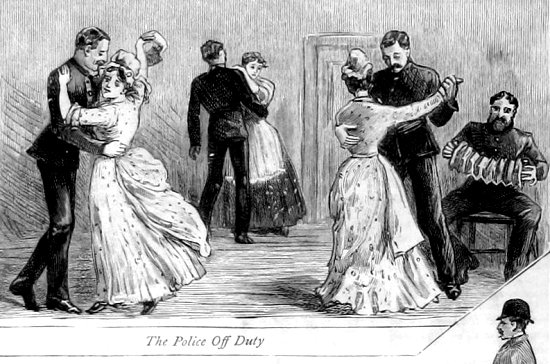
Policemen and partners at a house dance in the West of Ireland, 1887.
From The Graphic, London, Feb 19th, 1987
The Australian countryside in that country's colonial era was dotted with small, relatively isolated rural 'bush' settlements where dances in homes and barns provided an essential element of community. From an Australian parson's account of 1908:
I wish I could do justice to a Bush social. I wish I could show you the great chaff-shed, its slab walls draped in art-muslin, and its beams decorated with green boughs, the pianist seated in the corner, supported by a violinist, in some cases a real musical genius, whose thirsty soul has proved his undoing. At some Bush dances the music is provided by a concertina, energetically played by a stalwart young Bushman, who sits on his heels in the corner in an attitude characteristically Australian. Outside the shed a temporary supper-room has been built with great pine-poles and tarpaulins, and long trestle-tables groan beneath delicacies brought from far and near. There are turkeys and chickens from every farm within miles, sucking-pigs, hams, tongues, fruit and cakes, trifles, and innumerable other delicacies. At midnight the whole company sits down to supper, and thereafter dancing is renewed and continued until daybreak makes it possible for the tired dancers to see to drive home, some of them a distance of fifteen miles or more. 5
5
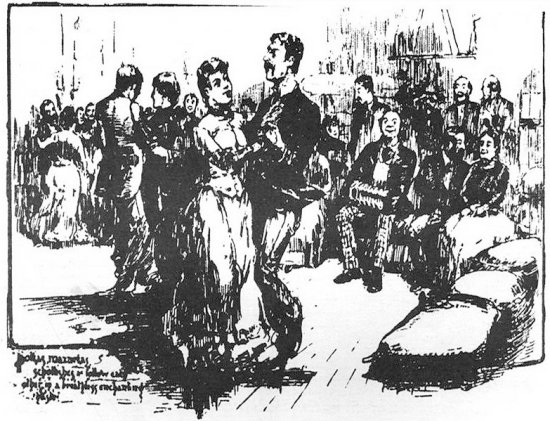
A wool shed dance in Australia, 1889.
Note the solo concertina player, and the bales of wool used for seating.
From the Illustrated Sydney News.
Because houses were typically small in rural areas at this time, instrumentation was limited to a concertina and maybe a fiddle. Clem O'Neal (1912-1980) came from Iron Bark (now Stuart Town) New South Wales Australia, and was one of the last concertina players produced in his district. He described the house dances there as follows:
The dances were out in country places, mostly in the houses (which normally had) dirt floors or flagstone floors. Quite a lot of the houses were small. Some people danced inside the house and quite a lot danced outside the house. The concertina player moved about from room to room carrying the concertina . . . and so there were times when those outside couldn't hear him. The player just moved around in among them and some (players) actually waltzed in time with them to get through. 6
6
Dances were often held outdoors in good weather, as in this account of a cross-roads dance in County Mayo Ireland, in 1904:
The scene is the King's highway in the ancient kingdom of Connaught; time, the dusky twilight of midsummer midnight ... The road just here runs through a vast expanse of bog, stretching away on either side to a far-away boundary of blue mountains, hardly to be distinguished now in the faint moonless light of this June midnight ...
The high-piled bonfire occupies half the road, and fragments are being blown and whirled about by the summer gale in a fashion that seems alarming. Standing about are some thirty or forty men and boys ... perhaps half that number of girls are crouching under the shelter of the boundary wall farthest from the fire. Their heads are bare, but they have shawls over their shoulders, and all, both men and women, are in everyday working clothes and hobnailed boots. The women in several instances have not even removed their aprons, as if any rearrangement of costume were considered unnecessary ...
Someone concealed from view is playing lively jig tunes on a concertina, and presently there is a movement in the little crowd; men select partners from among the ladies cowering under the wall, who doff their shawls, and the dance commences. It is formed of some ten or twelve couples; they mark well, with rough-shod feet, the rhythm of the tune on the hard road, and accurately observe intricate steps as they move in and out between other couples and turn their partners around, much in the fashion of a quadrille - all gone through with extreme gravity and decorum, till the dance is accomplished, and the fair sex retire once more into the shelter and obscurity of the wall. There ensues another interval, during which the men stand about as before.
The fire is occasionally replenished, and every few minutes the company break into a sort of subdued shouting, apparently for no particular cause; the concertina tunes are continuous, and are the liveliest feature of the gathering. 7
7
In the following recording, Ella Mae O'Dwyer (1906-1992) of Athea, West Limerick Ireland, plays Mrs O'Dwyers Fancy, which is comprised of old quadrille tunes (polkas). The recording is courtesy of Neil Wayne of Free Reed Records, who recorded Mrs O'Dwyer in 1974.
Also outdoors, at a 'bucksail' dance in South Africa in 1897:
We went on by way of Enkeldoorn (in the old Transvaal Province, now Gauteng South Africa), where there is a Dutch community, and where a "bucksail" dance was being held that night.... For the uninitiated, I may explain that a bucksail dance is held in the open. The ground is flattened down and the big tent or bucksail, which is used to cover wagons, is spread over it to form a dancing floor. Partners are selected, and these are retained during the whole of the dance, which generally lasts from sunset to sunrise, with intervals for refreshments. The orchestra usually consists of a concertina and guitar or fiddle, but in default of these a mouth-organ or two does suffice. The dance was a very vigorous one. 8
8
The Boer people had rustic farms scattered across the veldt. An English visitor recalled in 1900 a visit of some years previous:
And who has not heard of the Dutch dances at the Cape? ... They danced on the mud floor in the voorkammer - the living room of the house, into which the door opens from the outside - and the dust rose thicker and thicker until you could scarcely see across the other room. Then there was a pause, during which they watered the floor, and it, of course, became thick mud, and was ruination to the dresses. But the Boer girls generally change their frocks two or three times during the evening, in order to show off the extent of their wardrobe, and from their youth up are accustomed to dirt in the ballroom, so they do not take their soiled raiment much to heart. On they go, dancing merrily, often to the concertina where they can't get a piano, with their arms entwined around each other's necks in the Dutch fashion. 9
9
Johannes Petrus 'Silver' de Lange (1904-1956) was born in Vrededorp, a village near Johannesburg, South Africa. He formed a dance band called Die Vyf Dagbrekers (The Five Daybreakers) in the early 1930s. The following lively polka, Warm Patat (Hot Sweet Potato) is from a recording of that time, courtesy of Die Tradisionele Boeremusiekklub van S.A.
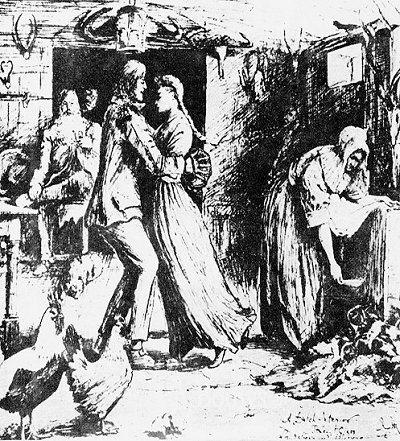
A Boer family dancing in their kitchen.
Drawn by John Guille Millais, 1895.
In rural England, a Northumberland vicar's wife invited local working class parishioners over for a dance in 1877, providing a bit of culture contrast between the genteel lady, who was used to quadrilles played on a piano, and working class youth, who were used to playing polkas on a concertina and fiddle:
Our dance came off Wednesday with great success ... Our guests arrived at 7; we were forty-four altogether; our music was the only thing which was not altogether successful. The fiddler whom we had engaged had felt so bashful in coming to what he considered such a grand house that he had cheered his spirits by a little whiskey first, and the whiskey seemed to have gone to his fingers and made his playing muddled. We varied his playing with quadrilles on the piano from me and polkas on the concertina from some of the young men.
You would have been surprised to see the number of dances they performed. They did everything that is danced in the ordinary ballroom, though their valsing [waltzing] did not come to much, besides they danced four or five kinds of country dances, schottische, reels and polkas. Some of them danced extremely well, and it was amusing to watch the difference in their dancing to that of people of our position. They put their whole energy into their dancing and thought of nothing else, conversation played no part in the proceeding, but the dancing was everything and had to be done as well as was possible. In fact, the faces of most of them were solemn all the time as if they were accomplishing an important task ... At 1:30, they all went home and left us very tired. 10
10
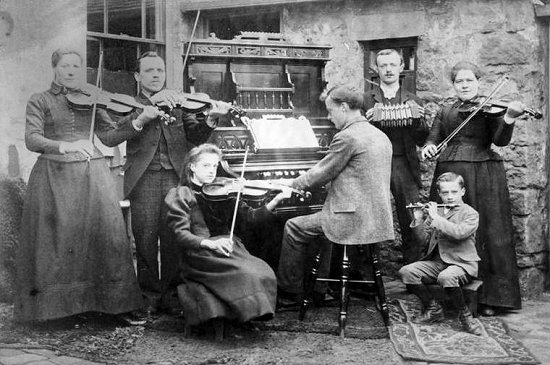
A family band in Darlington, Durham England, ca.1910.
Courtesy of The Beamish, The Living Museum of the North.
Dance musicians were typically semi-professionals and were paid for their work. They often traveled great distances to play at a dance. At the turn of the last century, in the tiny rural village of Duramama, near Bathurst in New South Wales, Australia, where concertina player Susan Colley (1881-1976) lived:
There was no public hall for the holding of dances and such-like functions. But dances were frequent. The younger folk, and some of the not-so-young, would congregate at the residence of a neighbour or acquaintance, coming by springcart (before the advent of a sulky), horseback or foot, and dance the whole night through to the music of a concertina or accordion.[The would] dance the Quadrilles, Lancers and Alberts, polkas, mazurkas, old time marches, etc., until after sun-up the next morning. 11
11
Mrs Colley recalled these dances, and the dress her mother made her for a rural ball, in this interview, recorded by Warren Fahey in 1973 when she was 92 years old.
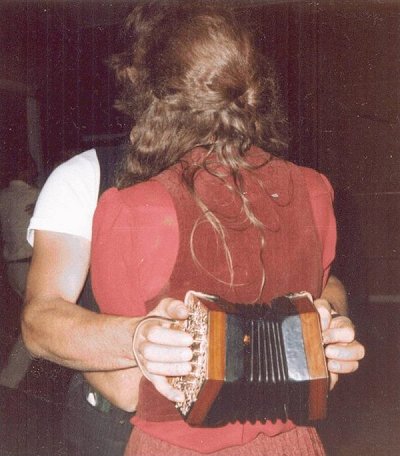
You dance with it. Ian Simpson dances with his wife Diane Simpson while he plays the concertina, c.1985.
This was an old party trick at house dances in all countries where the instrument was played;
Susan Colley remembers it in the above interview. Photo courtesy Peter Ellis.
Dooley Chapman recounted how his musical mentor Billy Chandler played for dances all over the region, using a bicycle for transport:
I've seen him leave Coborrah there of an evening making to Lue to play for a dance ... Mudgee's fifty mile, and another twenty down to where he was playing for the dance ... [T]hat's a long way to ride, don't you reckon! ... Of course, Lue's not the only place, other places as well.
The dancers, they'd start at eight o'clock. They'd go all night, of course. I'd be playing, and I'd get a bit of a lunch at half past one, and I'd play on until four o'clock. Because the ladies, or the girls, weren't allowed to leave until daylight, the breaking day ... so they wouldn't get away with somebody. 12
12
Percy Yarnold (1907-1988) of Wingham, New South Wales Australia was a concertina player for the Keightley Dance Band during his youth. He described his payment (twelve shillings) for a typical bush dance, in a 1985 interview with John Meredith (track courtesy of the National Library of Australia).
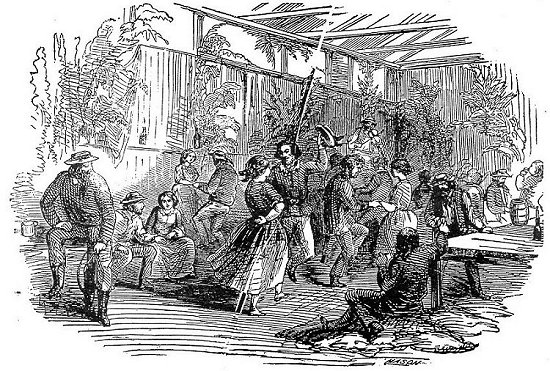
An Australian woolshed dance. From the Australian Town and Country Journal of December 24, 1870.
Note the solo fiddle player.
Notes:
3. Gearóid Ó hAllmhuráin, The Concertina in the Traditional Music of Clare, (PhD thesis, Queen's University Belfast, 1990).
4. Helen Brennan, 1999, The Story of Irish Dance, Brandon Books, Dingle Ireland, p.100.
5. C H S Matthews, A Parson in the Australian Bush (London: Edwin Arnold, 1908), pp.113-114.
6. Clem O'Neal, interviewed in Concertina Magazine, Australia, 1982.
7. Lady Onslow of Hengar, 1904, 'Midsummer Eve in Mayo', The Pall Mall Magazine, vol. 33 (1904), pp.429-430.
8. Gordon Le Seur, Cecil Rhodes, The Man and His Work (New York: McBride, Nast & Company, 1914), pp.157-158.
9. Beatrice M. Hicks, The Cape as I Found It (London: Elliot Stock, 1900), p.129.
10. Louise Creighton, writing in a letter (1877) quoted in James T Covert, A Victorian Marriage, (Continuum International Publishing Group, 2000), p.115.
11. Percy J Gresser, 1965, The Songs They Played - and the Dance Tunes They Played: unpublished notes, The Bush Music Club of Sydney, Australia.
12. Dooley Chapman, Your Good Self, CD, Chris Sullivan's Australian Folk Masters, CS-AFM-001, 2005.


![]() 7
7

![]() 10
10


![]() 12
12
